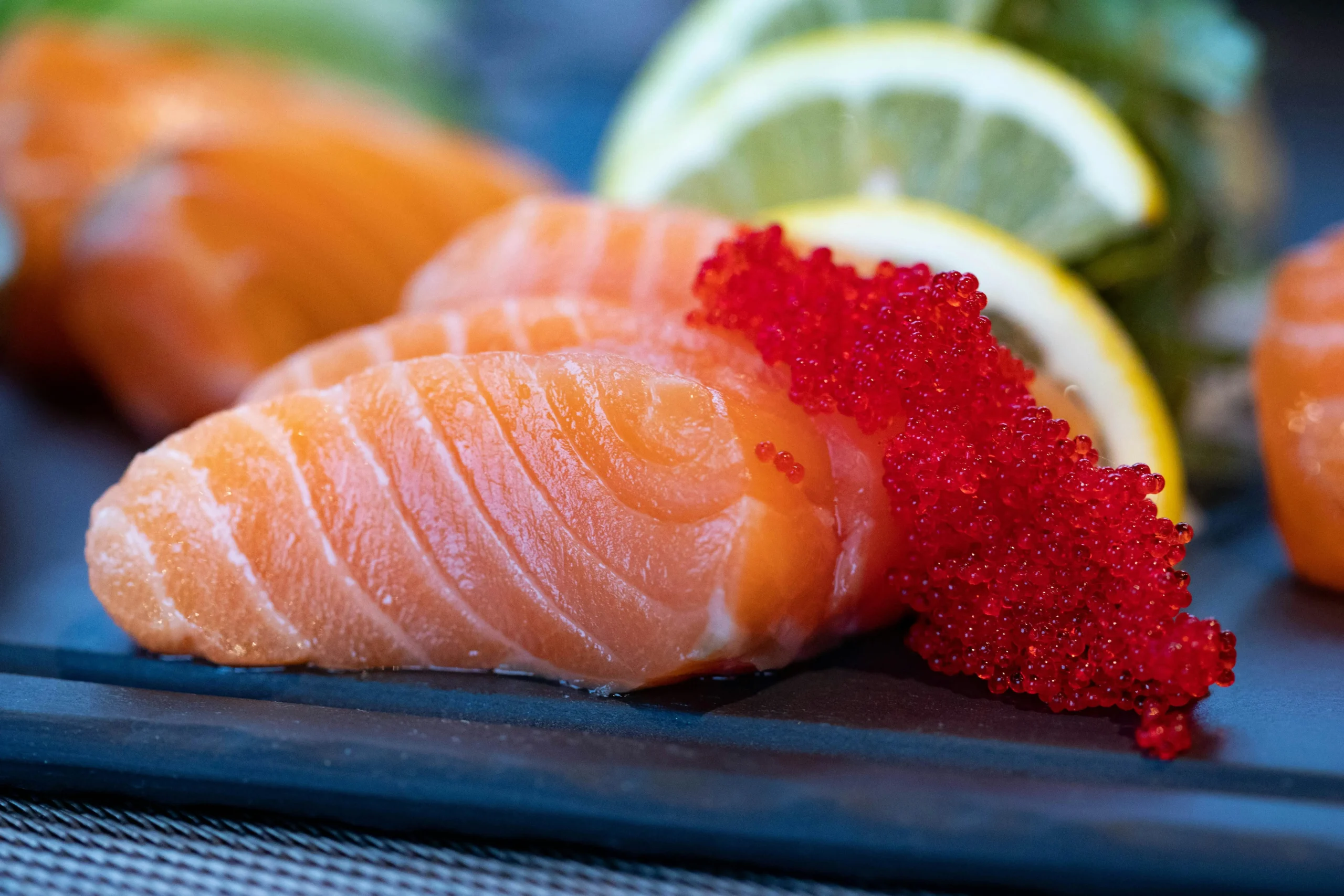
Sashimi is a celebrated Japanese dish that consists of thinly sliced raw fish or seafood, served fresh and often accompanied by soy sauce, wasabi, and pickled ginger. Renowned for its emphasis on quality and freshness, sashimi showcases the natural flavors and textures of the ingredients, making it a favorite among seafood enthusiasts. This culinary art form not only highlights the skill involved in preparation but also offers a unique dining experience that reflects the rich traditions of Japanese cuisine. If you’re curious to learn more about sashimi or its variations, below are 25 interesting facts about sashimi!
Origin: Sashimi has its roots in Japan, tracing back to the 8th century, during the Heian period. Initially, it was a method of preserving fish by preparing it raw and serving it with minimal seasoning. The practice evolved over centuries, influenced by regional fishing practices and culinary techniques. The term “sashimi” became more widely recognized in the Edo period (1603-1868), when it was served in restaurants, showcasing the artistry of Japanese cuisine. The emphasis on freshness and quality has remained a cornerstone of sashimi preparation to this day.
Meaning: The term “sashimi” (刺身) is derived from two Japanese characters: “sashi” (刺), meaning “to pierce” or “to cut,” and “mi” (身), meaning “body” or “flesh.” This name reflects the technique of slicing raw fish into thin pieces, emphasizing the skill involved in creating sashimi. The presentation is as important as the taste, with chefs often showcasing their knife skills to create visually appealing dishes. The precision in slicing not only enhances the aesthetic but also affects the texture and flavor of the fish, making it a true culinary art form.
Types of Fish: Sashimi can be made from a wide variety of fish and seafood, with some of the most popular choices being salmon, tuna, mackerel, and yellowtail. Each type of fish offers a unique flavor profile and texture, contributing to the overall experience. For example, salmon (sake) is known for its rich, buttery taste, while tuna (maguro) can vary in flavor depending on the cut, with fatty parts like toro being particularly prized. Other seafood options include octopus (tako), squid (ika), and shellfish such as scallops (hotate), showcasing the diversity of ingredients that can be used in sashimi preparation.
Sashimi vs. Sushi: While sashimi and sushi are often mentioned together, they are distinct dishes. Sashimi consists solely of raw fish or seafood, served without rice, while sushi includes vinegared rice as a fundamental component. The confusion arises because sushi can be served with sashimi on top, known as “nigiri.” Understanding this difference is crucial for appreciating the unique qualities of each dish. Sashimi emphasizes the purity of the fish, allowing diners to savor the flavor and texture without the added elements of rice or other ingredients.
Presentation: The presentation of sashimi is an important aspect of Japanese cuisine, as it reflects the chef’s skill and attention to detail. Sashimi is commonly served on a bed of finely shredded daikon radish, which adds a crisp texture and balances the richness of the fish. Garnishes such as wasabi, pickled ginger, and shiso leaves are often included, enhancing the visual appeal and flavor profile. The arrangement of the sashimi pieces is carefully considered, often reflecting seasonal themes or artistic designs, creating a feast for both the eyes and the palate.
Health Benefits: Sashimi is not only a delicacy but also a nutritious option. It is high in protein, with a typical serving providing around 20-30 grams, depending on the type of fish. Additionally, sashimi is rich in omega-3 fatty acids, which are essential for heart health and have been shown to reduce inflammation. The low carbohydrate content makes it suitable for various dietary preferences, including low-carb and ketogenic diets. Consuming sashimi can also contribute to a balanced diet, providing essential nutrients without the added calories found in fried or heavily processed foods.
Slicing Technique: The art of slicing sashimi, known as “sukiyaki,” requires a high level of skill and precision. Chefs use a specially designed knife called “yanagiba,” which is long and thin, allowing for smooth, clean cuts. The technique involves slicing the fish at a 45-degree angle to maximize tenderness and enhance the flavor experience. The thickness of the slices can vary, typically ranging from 0.5 to 1 cm, depending on the type of fish and the chef’s preference. Mastering this technique takes years of practice, as the goal is to create pieces that are not only aesthetically pleasing but also melt in the mouth.
Tuna: Bluefin tuna is considered one of the most sought-after fish for sashimi, prized for its rich flavor and high-fat content. The demand for bluefin tuna has led to remarkable prices at auctions, with a record-setting sale reaching up to $3 million in 2019 at the Toyosu Market in Tokyo. This auction marks the beginning of the new year and attracts chefs and buyers from around the world. The high price reflects both the quality of the fish and the significant cultural value placed on bluefin tuna in Japanese cuisine. The fish is often served as sashimi in various forms, including the coveted fatty belly cut known as “otoro,” which is renowned for its melt-in-your-mouth texture and rich flavor. The sustainability of bluefin tuna has become a topic of concern, prompting discussions about responsible fishing practices and conservation efforts to protect this species.
Sashimi Grade: The term “sashimi grade” refers to fish that meets strict standards for freshness, quality, and safety, making it suitable for raw consumption. To be labeled as sashimi grade, fish must be handled with care throughout the supply chain, from catch to preparation. In many cases, fish intended for sashimi is frozen at temperatures of -20°C (-4°F) for at least 7 days to eliminate potential parasites, ensuring the safety of the product. This rigorous process underscores the importance of sourcing high-quality fish, as the freshness and handling directly impact the flavor and safety of the sashimi served to consumers.
Cultural Significance: Sashimi holds a special place in Japanese culture, often served during significant occasions such as New Year’s celebrations, weddings, and other festive gatherings. The dish is not only a culinary delight but also a symbol of hospitality and respect for guests. In traditional Japanese dining, the presentation and preparation of sashimi reflect the chef’s skill and dedication to the craft. Additionally, sashimi is often enjoyed in a communal setting, where diners share a variety of fish, fostering a sense of togetherness and appreciation for the artistry of Japanese cuisine. The cultural significance of sashimi extends beyond its taste, embodying the values of seasonality, freshness, and respect for ingredients that are central to Japanese culinary traditions.
Varieties: Sashimi encompasses a wide range of fish and seafood, each offering distinct flavors and textures. Popular varieties include “sake” (salmon), known for its rich, buttery taste and vibrant color; “maguro” (tuna), which can be further categorized into different cuts such as “akami” (lean) and “toro” (fatty belly); and “hamachi” (yellowtail), prized for its firm texture and mild flavor. Other options include “tako” (octopus), “ika” (squid), and “hotate” (scallops). The diversity in sashimi allows for a unique tasting experience, with chefs often selecting seasonal fish to highlight freshness and quality. The choice of fish can also reflect regional specialties, showcasing the local fishing practices and culinary traditions.
Serving Size: A typical serving of sashimi usually consists of 5 to 10 pieces, which can total around 100 to 200 grams (3.5 to 7 ounces). The exact serving size may vary depending on the type of fish and the dining context. In formal settings, sashimi is often served as an appetizer, allowing diners to savor the flavors before the main course. In sushi restaurants, sashimi may be offered as part of a larger platter or omakase menu, where chefs curate a selection of seasonal fish. The presentation of the sashimi is also important, with pieces arranged artfully on the plate to enhance the dining experience.
Wasabi: Authentic wasabi (Wasabia japonica) is a key accompaniment to sashimi, known for its unique flavor and pungency. Real wasabi is difficult to cultivate and can cost up to $250 per kilogram, leading many restaurants to use a substitute made from horseradish, mustard, and food coloring. When served with sashimi, wasabi not only enhances the flavor of the fish but also has antimicrobial properties that can help reduce the risk of foodborne illness. In traditional Japanese dining, diners often mix a small amount of wasabi into their soy sauce, though it is also common to place a dab directly on the sashimi itself for a more intense flavor experience.
Sashimi and Alcohol: Sashimi pairs well with various alcoholic beverages, most notably sake, a traditional Japanese rice wine. The flavors of sake can complement the delicate taste of sashimi, enhancing the overall dining experience. There are different types of sake, including junmai, ginjo, and daiginjo, each with unique flavor profiles and aromas. In addition to sake, sashimi can also be enjoyed with shochu (a distilled spirit) or even light beers, which provide a refreshing contrast to the richness of the fish. The choice of beverage often depends on personal preference and the specific type of sashimi being served.
Sashimi in the U.S.: Sashimi began gaining popularity in the United States during the sushi boom of the 1980s, as Japanese cuisine became more mainstream. Sushi restaurants began to include sashimi on their menus, introducing diners to the concept of enjoying raw fish. The rise of health-conscious eating and the increasing availability of high-quality fish contributed to the growing appreciation for sashimi. Today, many sushi bars and restaurants across the country offer a variety of sashimi options, often featuring both traditional Japanese varieties and locally sourced fish, reflecting the evolving tastes of American diners.
Record Price: The annual Tuna Auction at the Toyosu Market in Tokyo is famous for its record-setting prices, with the highest price ever paid for a single bluefin tuna reaching $3.1 million in 2019. This auction marks the beginning of the new year and attracts chefs, buyers, and media from around the world. The high price reflects not only the quality of the fish but also the cultural significance placed on bluefin tuna in Japanese cuisine. The auction highlights the competitive nature of the market and the demand for premium sashimi-grade fish, prompting discussions about sustainability and the future of bluefin tuna fishing.
Preparation Time: Preparing sashimi can be a time-intensive process, taking anywhere from 20 minutes to several hours, depending on the type of fish and the complexity of the dish. The preparation involves selecting the freshest fish, cleaning, filleting, and slicing it into delicate pieces. Chefs must also pay attention to presentation, arranging the sashimi artfully on the plate. The skill required for this process is honed through years of training, as the quality of the sashimi relies heavily on the chef’s expertise in handling and preparing the fish. The time invested in preparation is reflected in the final dish, showcasing the dedication to quality and craftsmanship.
Fish Freshness: Sashimi is best consumed within 24 hours of preparation to ensure optimal freshness and safety. The quality of sashimi is heavily reliant on the freshness of the fish, as it is served raw. Consuming sashimi that is not fresh can lead to foodborne illnesses, making it crucial for both restaurants and home cooks to use fish that has been sourced and handled properly. Many sushi chefs emphasize the importance of using fish that has been caught and delivered within a day to maintain its delicate flavor and texture.
Sashimi and Umami: The umami flavor in sashimi is enhanced by the natural fats in the fish, particularly in fatty species like salmon. Umami, often described as a savory taste, is one of the five basic tastes and is attributed to the presence of certain amino acids and nucleotides in food. Fatty fish, such as salmon and tuna, have higher fat content, which not only contributes to a richer taste but also enhances the overall mouthfeel. This combination of fat and the natural flavors of the fish creates a satisfying and complex tasting experience that is highly sought after in sashimi.
Slicing Angle: The ideal angle for slicing sashimi is typically around 45 degrees to maximize tenderness and flavor. This technique is known as “saku” in Japanese cuisine and is essential for achieving the perfect bite. Slicing at this angle allows for a larger surface area, which can enhance the fish’s flavor profile and tenderness. Additionally, the skillful presentation of sashimi is vital, as the way the fish is cut can affect not only the taste but also the visual appeal, making it an art form as much as a culinary technique.
Sashimi Platter: A traditional sashimi platter may include a variety of fish, often arranged artistically, and can cost between $30 to $100 depending on the selection. These platters are a celebration of the chef’s skills and the quality of the ingredients used. They typically feature a diverse array of fish, such as tuna, yellowtail, and octopus, each prepared with precision. The presentation is key, as chefs often use garnishes like shiso leaves and daikon radish to enhance the visual appeal. The price of a sashimi platter can vary significantly based on the types of fish included, with rare or premium varieties commanding higher prices.
Sashimi in Other Cultures: While primarily Japanese, variations of sashimi can be found in other cultures, such as Korean “hoe” and Hawaiian “poke.” Each of these dishes showcases the local ingredients and culinary traditions of their respective cultures. For example, hoe is often served with a spicy sauce and accompanied by vegetables, while poke features cubed fish mixed with seasonings and toppings like avocado and seaweed. These variations highlight the global appreciation for raw fish dishes and the diverse ways they can be enjoyed.
Sashimi Etiquette: In Japan, it is customary to eat sashimi with chopsticks and to avoid mixing wasabi into soy sauce. This etiquette reflects the cultural significance of sashimi and the respect for the chef’s preparation. Traditionally, wasabi is applied directly to the fish, allowing diners to appreciate the individual flavors without diluting them in soy sauce. Understanding and following these customs enhances the dining experience and shows respect for the culinary traditions of Japanese cuisine.
Sashimi Safety: The FDA recommends that fish intended for raw consumption be frozen at -20°C (-4°F) for at least 7 days to eliminate parasites. This guideline is crucial for ensuring food safety when consuming raw fish. Freezing at these temperatures kills parasites that may be present in the fish, making it safe for consumption. Restaurants and sushi bars often adhere to these regulations to protect their customers, and home cooks should also be aware of these safety measures when preparing sashimi at home.
Sashimi Events: The annual Tuna Auction at the Toyosu Market in Tokyo attracts chefs and buyers from around the world, showcasing the global interest in sashimi. This event is famous for its high-stakes bidding, where premium tuna can sell for hundreds of thousands of dollars. The auction not only highlights the quality of the fish but also serves as a cultural event, drawing attention to the importance of seafood in Japanese cuisine. Chefs from various countries attend to source the best fish for their restaurants, underscoring the international appeal of sashimi and the culinary artistry involved in its preparation.
Frequently Asked Questions About Sashimi
What is Sashimi?
Sashimi is a Japanese dish consisting of very fresh raw seafood, often fish, sliced into thin pieces. It is typically served without any sauce or seasoning, allowing the natural flavor of the fish to shine through. Sashimi is often accompanied by wasabi (a spicy horseradish paste) and soy sauce for dipping.
What types of fish are commonly used for sashimi?
The most common types of fish used for sashimi include:
- Tuna: Known for its rich, buttery flavor and firm texture.
- Salmon: Popular for its slightly sweet taste and delicate texture.
- Yellowtail: Has a firm, slightly chewy texture and a mild, slightly sweet flavor.
- Mackerel: Offers a strong, slightly oily flavor and a soft texture.
- Squid: Has a tender, chewy texture and a mild, slightly sweet flavor.
- Scallops: Known for their sweet, delicate flavor and soft texture.
- Shrimp: Offers a sweet, slightly briny flavor and a firm, chewy texture.
How is sashimi prepared?
The preparation of sashimi requires great skill and precision. The fish must be extremely fresh and of the highest quality. It is typically sliced very thinly and served immediately to maintain its freshness.
What is the best way to eat sashimi?
Sashimi is typically eaten with chopsticks. The fish is dipped in soy sauce and wasabi before being placed in the mouth. The combination of the fish’s natural flavor, the salty soy sauce, and the spicy wasabi creates a delicious and harmonious taste.
Is sashimi safe to eat?
Yes, sashimi is generally safe to eat as long as the fish is extremely fresh and has been properly prepared. However, it is important to avoid eating raw fish that is not from a reputable source.
What are the health benefits of eating sashimi?
Sashimi is a good source of lean protein, omega-3 fatty acids, and essential minerals. It is also low in calories and fat.
Are there any risks associated with eating sashimi?
Eating raw fish can pose a risk of foodborne illness, such as food poisoning. To minimize this risk, it is important to only eat sashimi from reputable sources and to ensure that the fish is fresh and properly prepared.
What is the difference between sashimi and sushi?
While both sashimi and sushi involve raw fish, they are different dishes. Sashimi consists of thinly sliced raw fish served without any rice. Sushi, on the other hand, is made by placing a piece of fish or other topping on a bed of vinegared rice.
Can vegetarians or vegans eat sashimi?
No, sashimi is not suitable for vegetarians or vegans as it is made from raw fish. However, there are many other vegetarian and vegan options available, such as vegetable sushi rolls or tofu dishes.









